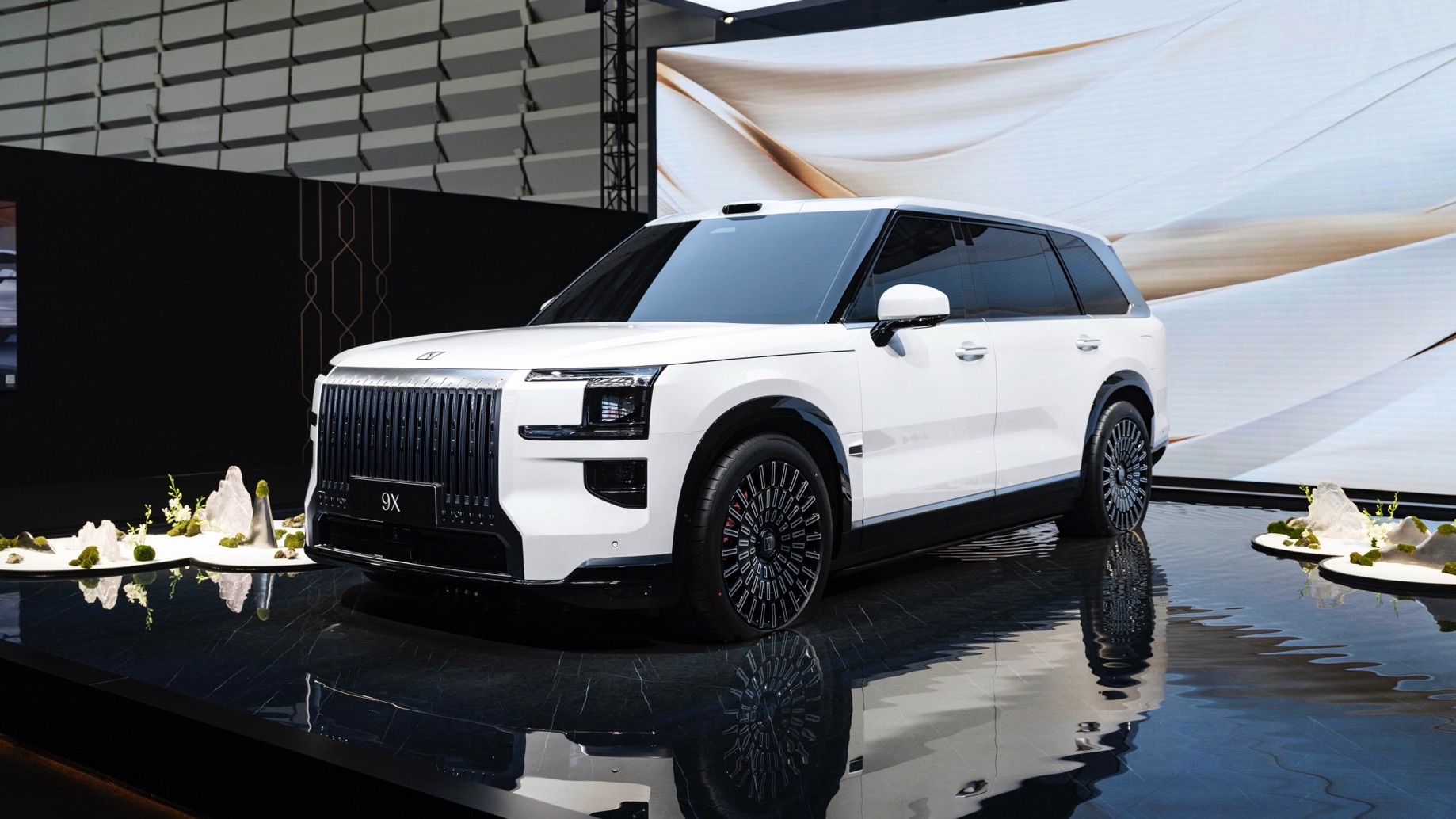What truly defines a luxury car in the electric era? Many autonomous brands have already provided answers. Tonight, ZEEKR has revealed its own response with the 9X.
The 9X technical architecture gives off the first impression of being a “material-stacking fanatic.” From a 900 V high-voltage hybrid architecture, a 70 kWh 6C battery, 0-100 km/h acceleration in 3.1 seconds, 1,400 TOPS of assisted driving computing power, to a 48 V active stabilizer bar, these keywords underscore that the hardware parameters of the ZEEKR 9X lead the industry both in terms of performance and intelligence.
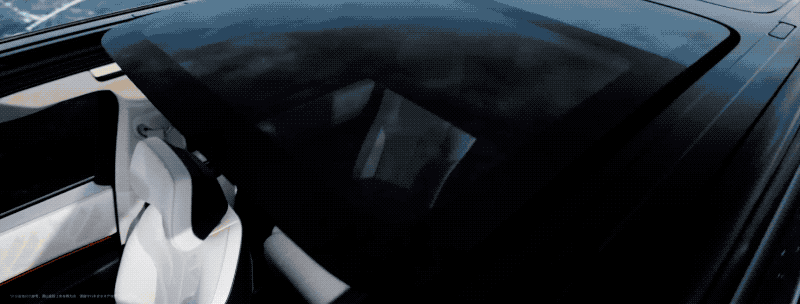
Tonight, Geely Vice President Lin Jie took the stage, unveiling the interior design and an all-black exterior design of the 9X. Starting today, the ZEEKR 9X will initiate the Early Enjoyment Plan and is set to begin pre-sales at the Chengdu Auto Show at the end of August.
What technical advantages does the ZEEKR 9X hold to earn its ultra-luxury status?
ZEEKR’s First Hybrid
For the first time, the electric-hybrid system makes its way into the ZEEKR brand, named the Vast Super Electric Hybrid.
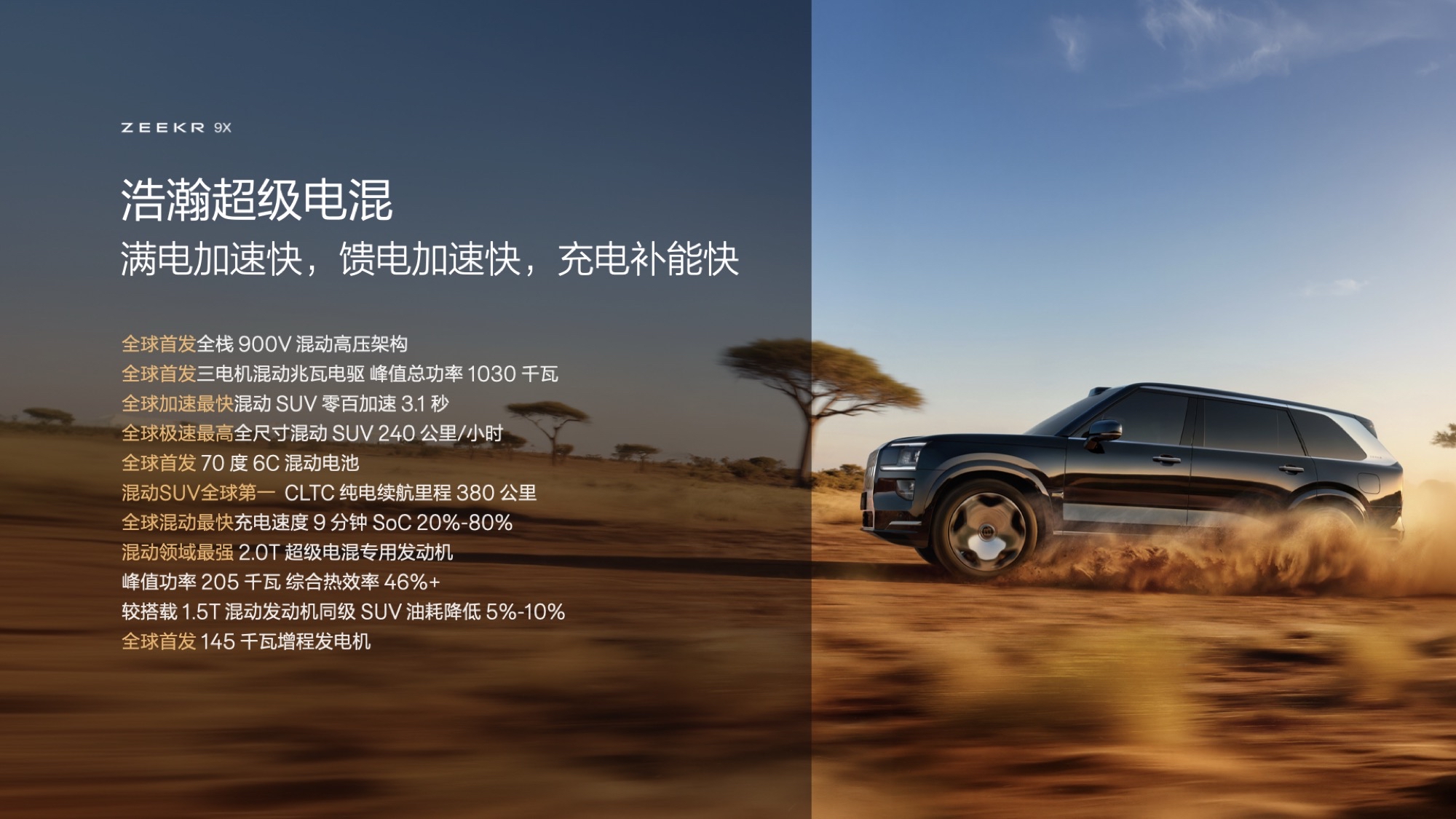
While hybrid vehicles on the market have largely shed their reputation as “useless without electricity,” they still face shortcomings like short pure electric range, slow charging, poor battery-powered performance, high fuel consumption, and significant noise.
The Vast Super Electric Hybrid presents the first fully integrated 900 V high-voltage architecture in a hybrid vehicle, a 55/70 kWh large battery, a megawatt electric drive, a 2.0T engine, and a high-power generator to enhance both electric and hybrid driving experiences.
The ZEEKR 9X’s full-stack 900 V high-voltage architecture greatly enhances charging speed and range, while also managing energy consumption judiciously. This 900 V high-voltage architecture offers two battery versions, 55 kWh and 70 kWh, both employing CATL NCM Yao battery technology. The 55 kWh version achieves a CLTC range of over 300 km, while the 70 kWh version reaches a CLTC range of 380 km.
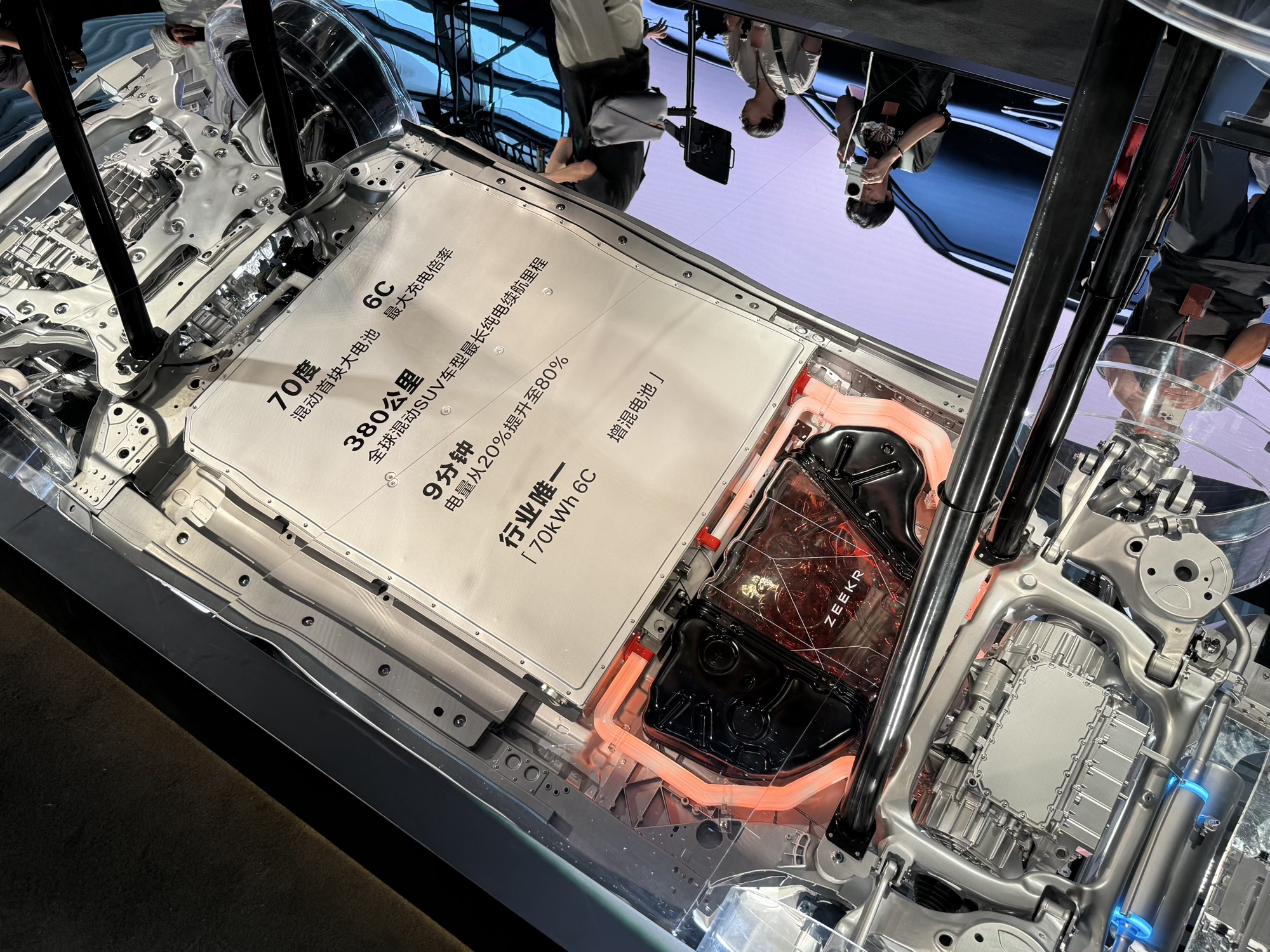
The charging capability is equally impressive, with a 6C charge rate that takes the 9X battery from 20% to 80% in just 9 minutes, and from 10% to 80% in only 10.3 minutes.
If charging at a mall, from entrance, charging, to exit, the entire process might take less than 15 minutes, with no fees required.
In terms of power, the ZEEKR 9X employs a three-motor drive and also supports direct engine drive. The front axle is equipped with a 290 kW motor, while the rear axle has dual 370 kW motors, achieving a total maximum output of 1,030 kW (approximately 1,381 horsepower). The engine, with a maximum power of 205 kW, is capable of directly driving the wheels.This time, the ZEEKR 9X is directly compared with supercars/super SUV, namely Lamborghini Huracán, Ferrari Roma, and Porsche 911 Carrera. The result is predictable, the ZEEKR 9X emerges victorious.
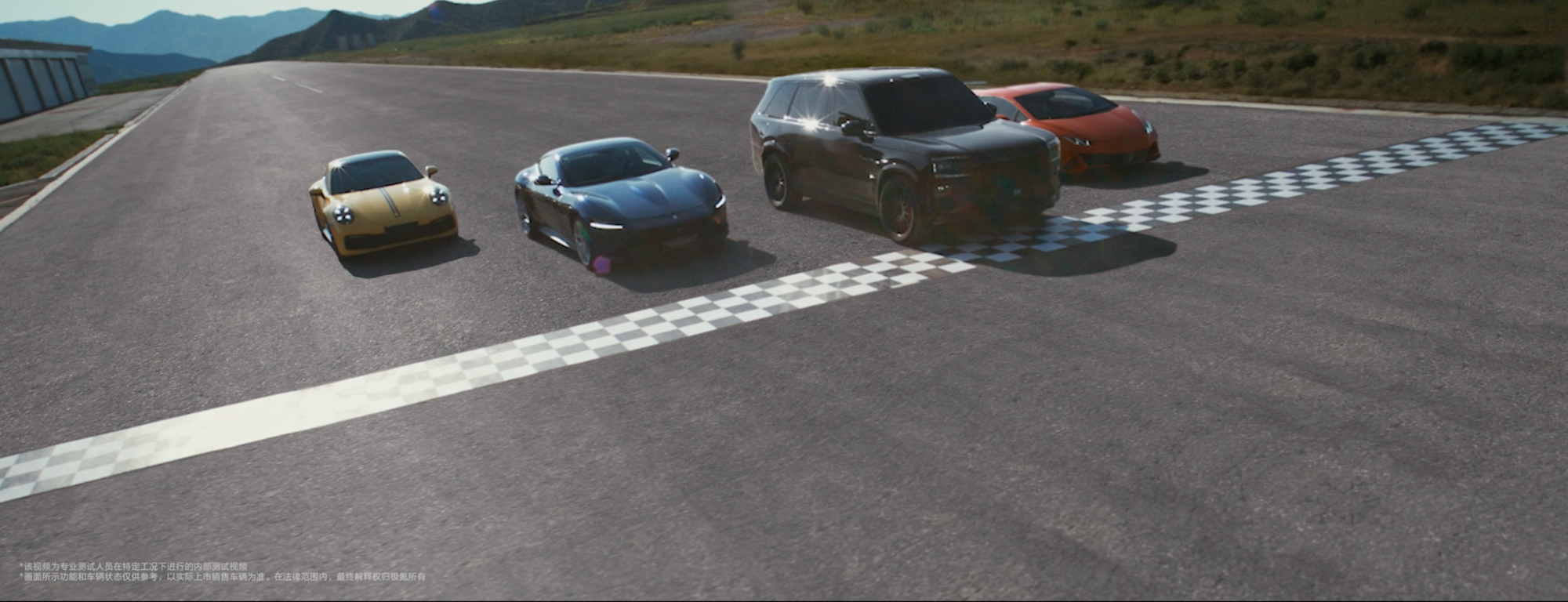
According to official data, the 9X accelerates from 0 to 100 km/h in 3.1 seconds, matching the acceleration capability of the Tesla Model 3 Performance.
Among all stock SUVs, perhaps only three models can surpass the 9X, but two of them are not available through official channels in the Chinese market. These three cars are the LOTUS ELETRE (official 0 to 100 km/h in 2.95 seconds), Tesla Model X Plaid (official 0 to 100 km/h in 2.6 seconds), and Rivian R1S (official 0 to 60 mph in 2.6 seconds). In the hybrid SUV category, the ZEEKR 9X is the fastest in acceleration.
Moreover, the 3-second level acceleration capability is available across all models.
In hybrid systems, the engine’s capability is more crucial. The ZEEKR 9X is equipped with a 2.0T engine, peak power of 205 kW, and thermal efficiency reaching 46%. This engine can directly drive the wheels or drive the generator for range extension mode. Currently, in the market’s range-extended power models, the generator power is generally relatively small (mostly less than 100 kW), leading to a noticeable decline in performance when the battery charge is low.
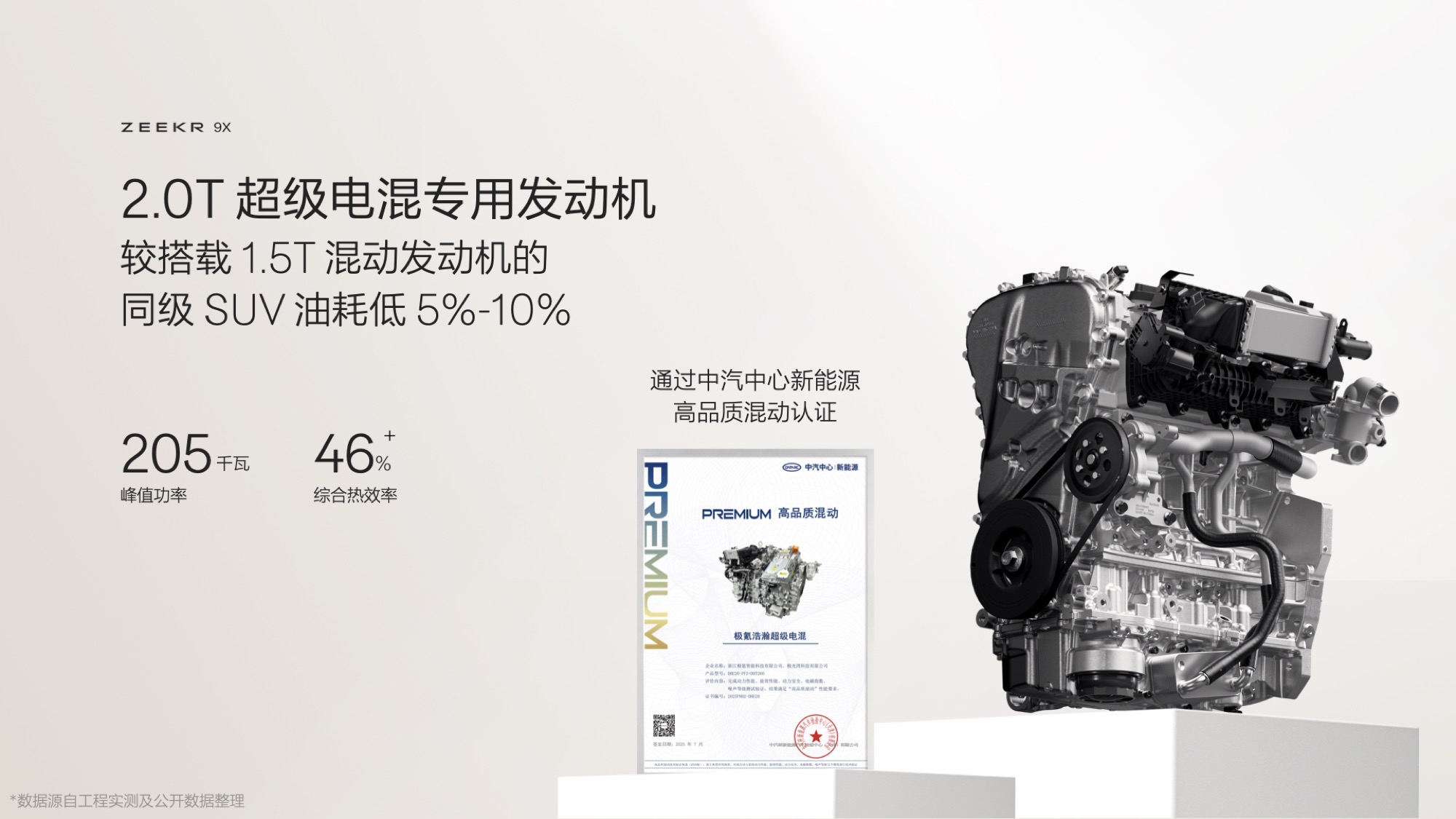
The 9X, however, boasts 145 kW generator power, capable of starting at 5% battery level. With the engine directly driving as well, performance remains strong, with full charge and low charge 0 to 100 km/h acceleration differing by only 0.2 seconds.
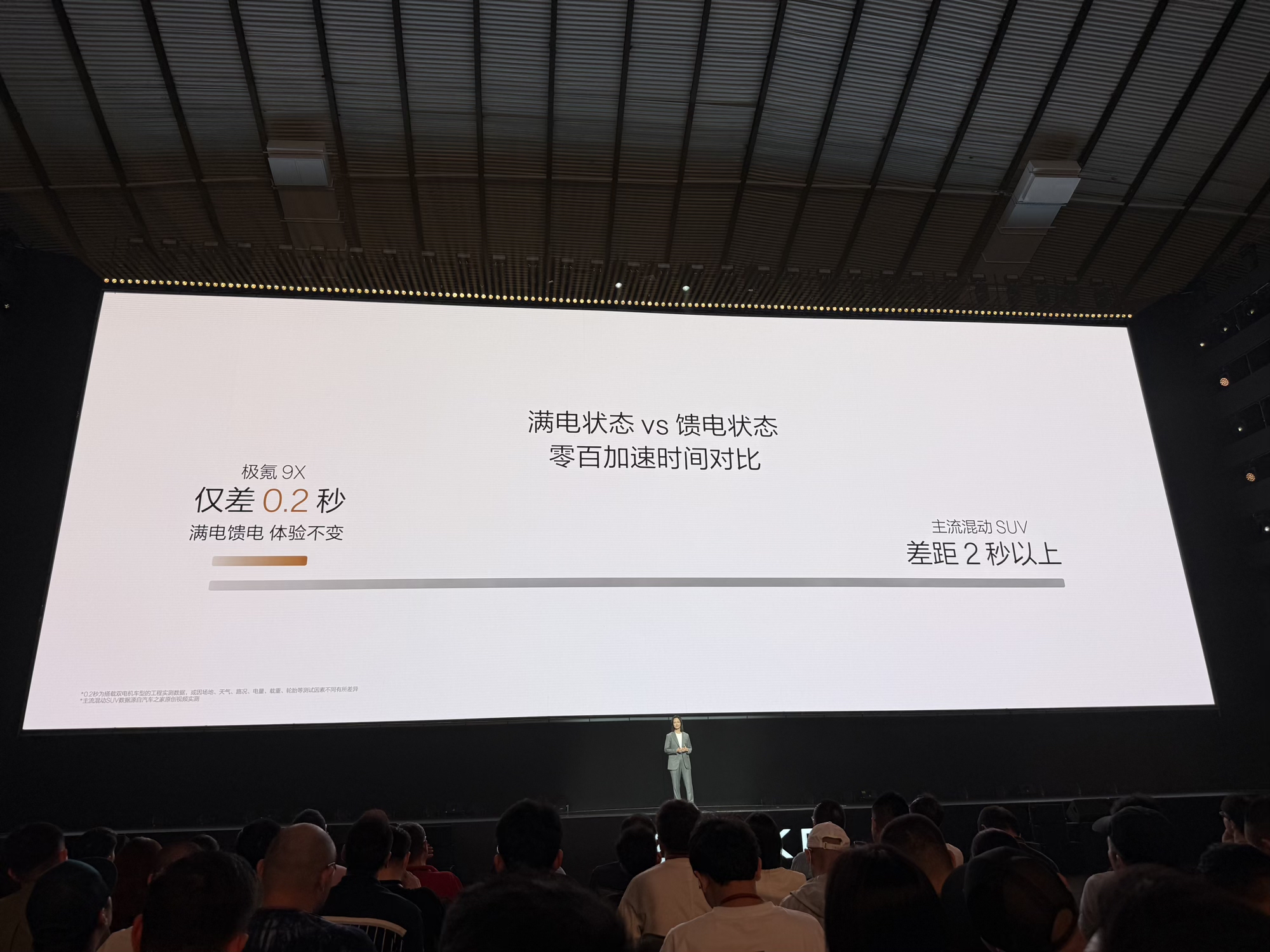
In terms of vehicle operating costs, the ZEEKR 9X can run on 92-octane gasoline, with fuel consumption 5% – 10% lower than comparable 1.5T engines, thus achieving lower operating costs.
ZEEKR’s L3 is Here
This year, Huawei and Xpeng have successively released models that support L3, with hardware first and features to come later. On the ZEEKR 9X, the L3-targeted launch also includes the Qianli Haohan H9 plan, with the slightly lower-positioned Qianli Haohan H7 available as an option.
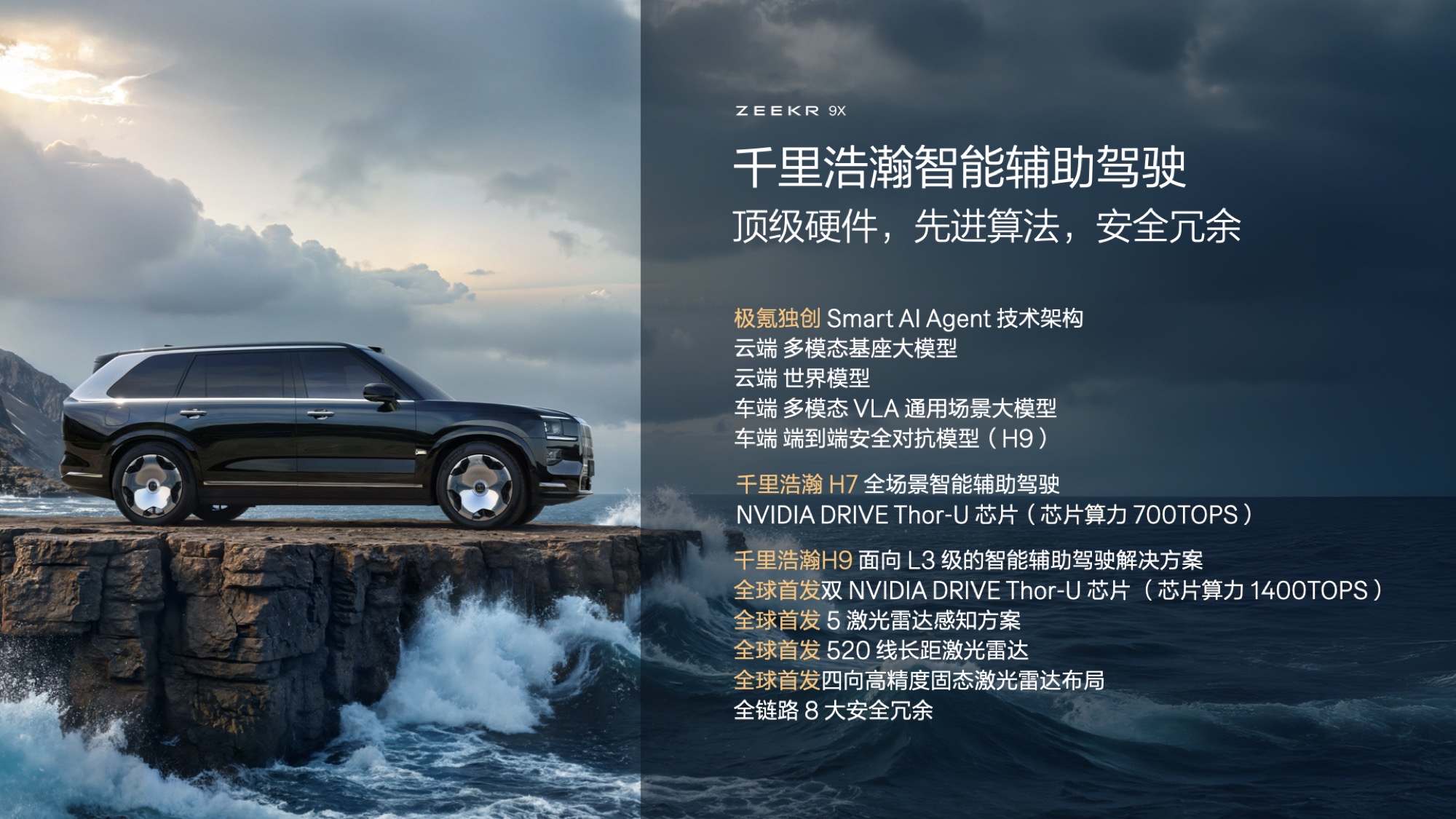 Among them, the Qianli Haohan H7 is equipped with a Thor-U chip, providing computing power of 700 TOPS. Chris Chen, Vice President of ZEEKR Intelligent Technology, announced the image-free park roaming feature based on Qianli Haohan H7, showcasing the capabilities of ZEEKR VLA large model for the first time. He described this as the ultimate experience in L2 level assisted driving.
Among them, the Qianli Haohan H7 is equipped with a Thor-U chip, providing computing power of 700 TOPS. Chris Chen, Vice President of ZEEKR Intelligent Technology, announced the image-free park roaming feature based on Qianli Haohan H7, showcasing the capabilities of ZEEKR VLA large model for the first time. He described this as the ultimate experience in L2 level assisted driving.
The image-free park roaming is divided into two scenarios. The first scenario is parking and exiting the garage. After the driver gets into the car, they only need to say, “Hi Eva, drive to the exit,” and the vehicle will start independently searching for the exit. Along the way, commands such as “Change the exit” or “Turn left ahead” can be given, and the vehicle will re-plan the route.
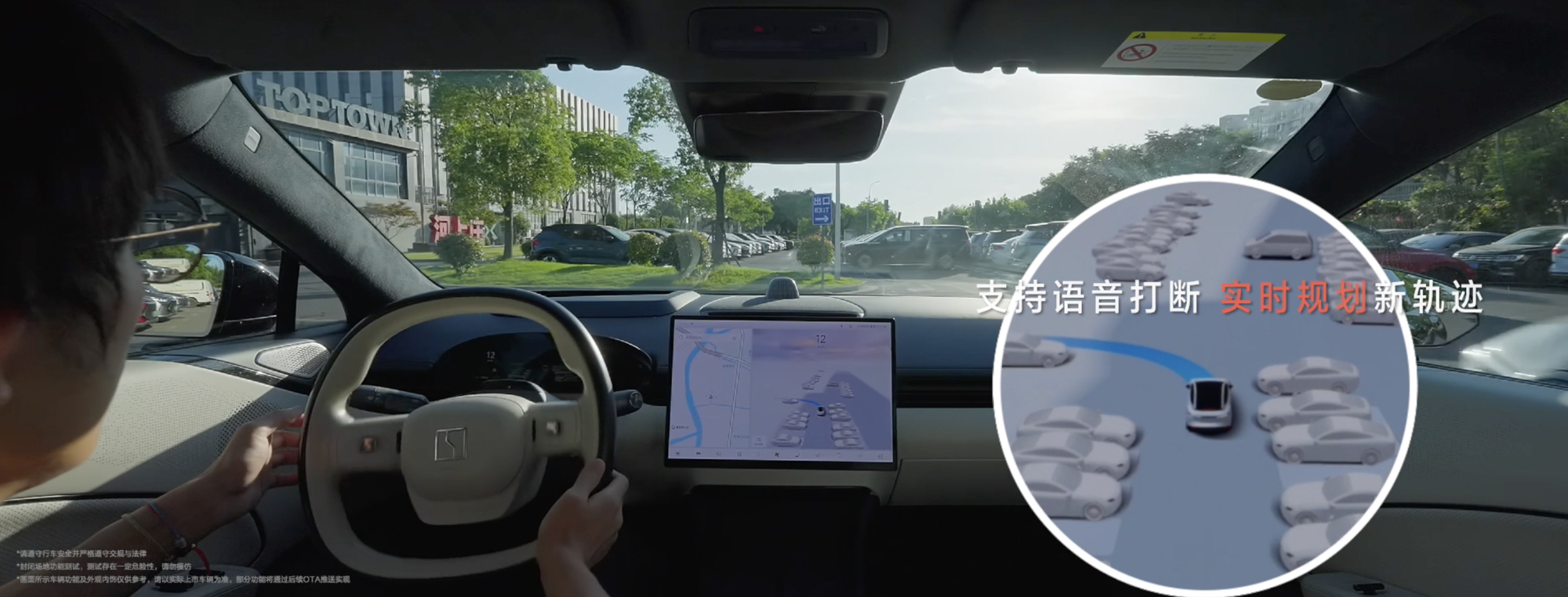
The second scenario is parking in a complex parking lot. While the vehicle roams to find a parking space, the driver can issue commands like “Turn left ahead” or “Park nearby,” controlling the vehicle to park into a spot using voice commands.
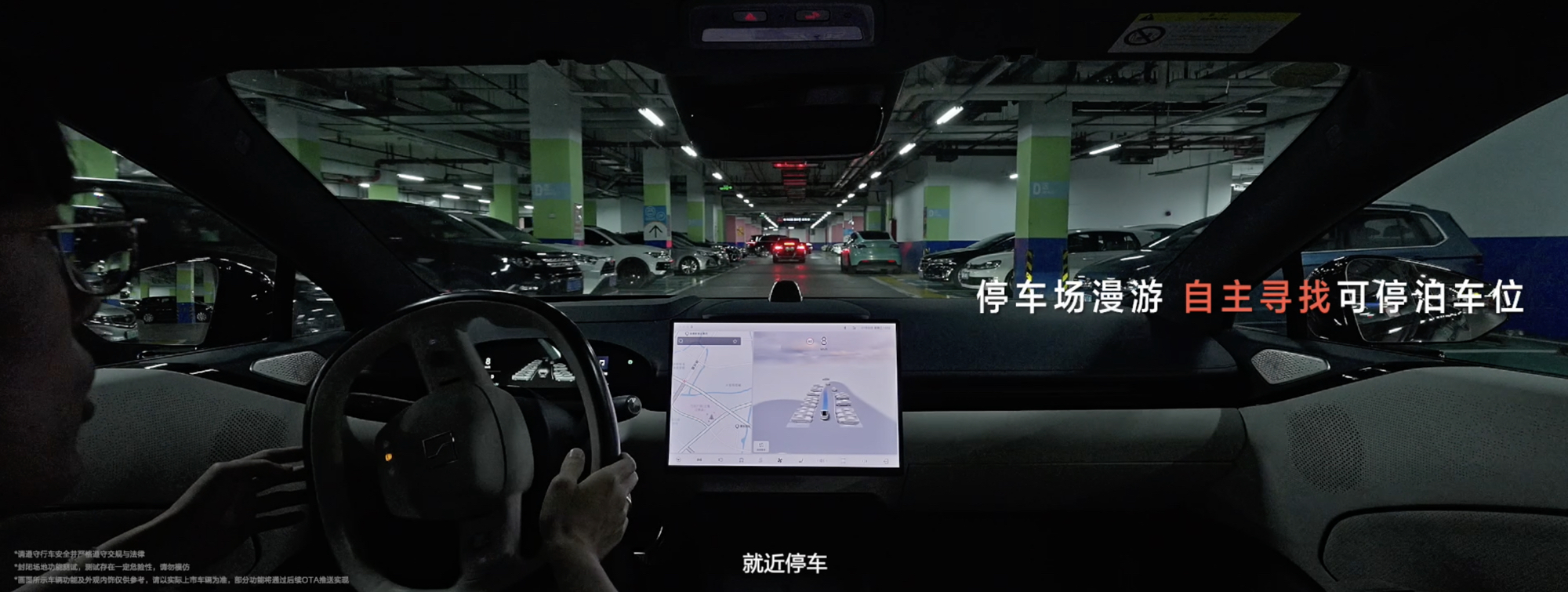
Furthermore, the image-free park roaming function does not require prior learning; it can be used even in parking lots the vehicle is visiting for the first time.
The Qianli Haohan H9 is more robust in terms of hardware, achieving a three-layer, 360-degree coverage of lidar, vision, millimeter wave, and ultrasonic perception, with the number of external perception hardware reaching 43, including:
- 5 lidars, including 1 forward 520-line lidar and 4 solid-state lidars;
- 13 cameras;
- 5 millimeter-wave radars;
- 12 ultrasonic radars;
- 2 water depth radars;
- 6 external microphones.
The 520-line lidar can identify small objects measuring 0.75 m*0.75 m from 300 meters away.
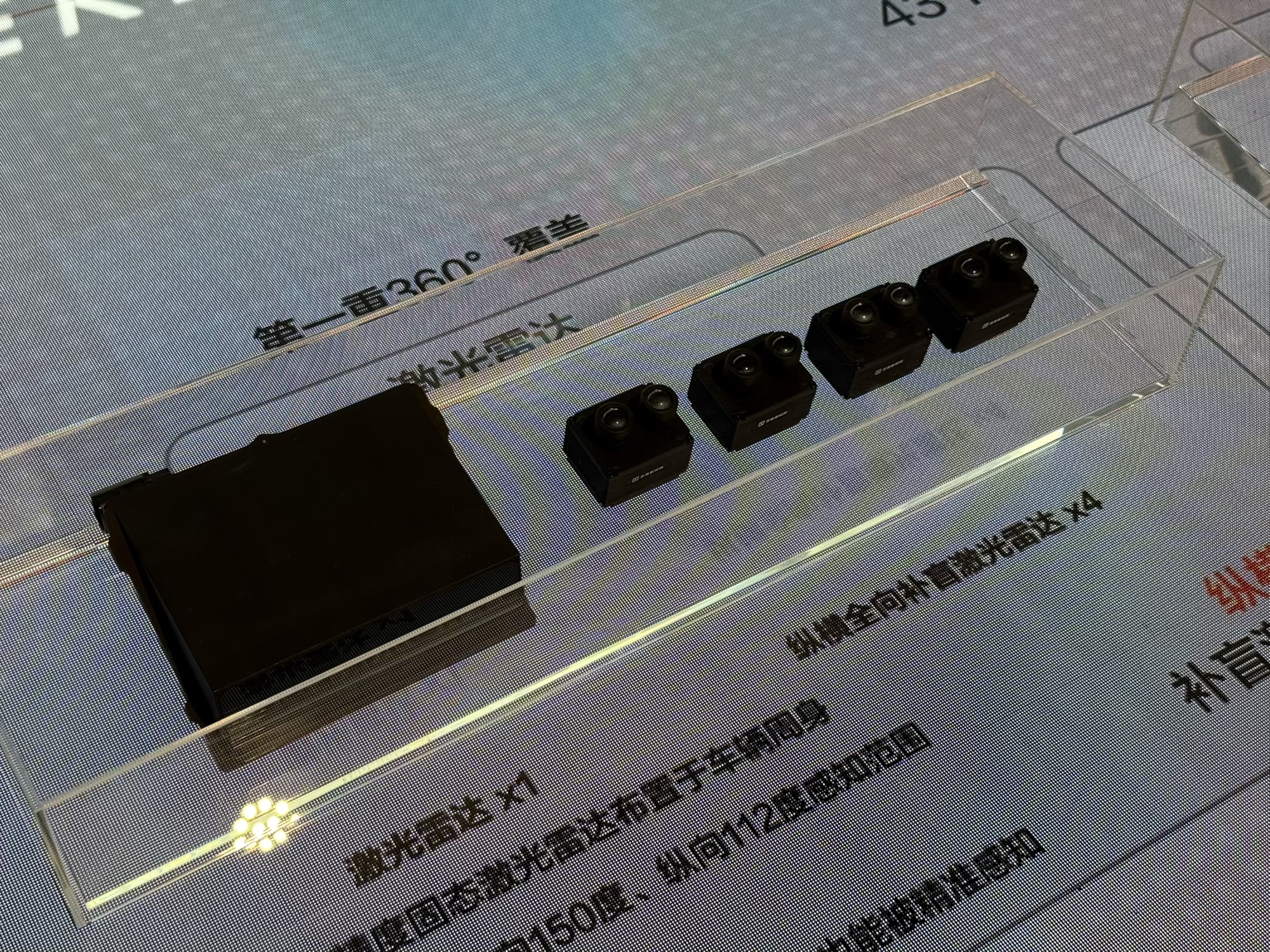
The 4 solid-state lidars are arranged at the front, rear, left, and right of the 9X, achieving a longitudinal perception of 112 degrees and horizontal perception of 150 degrees, with a sensing distance of 15 meters. These 4 solid-state lidars can more accurately identify negative obstacles, suspended obstacles, and low obstacles, mainly used in low-speed parking scenarios.
Apart from its powerful perception capability, the Qianli Haohan H9’s computational ability also reaches a new level, with ZEEKR independently researching and producing a dual Thor-U chip domain controller.
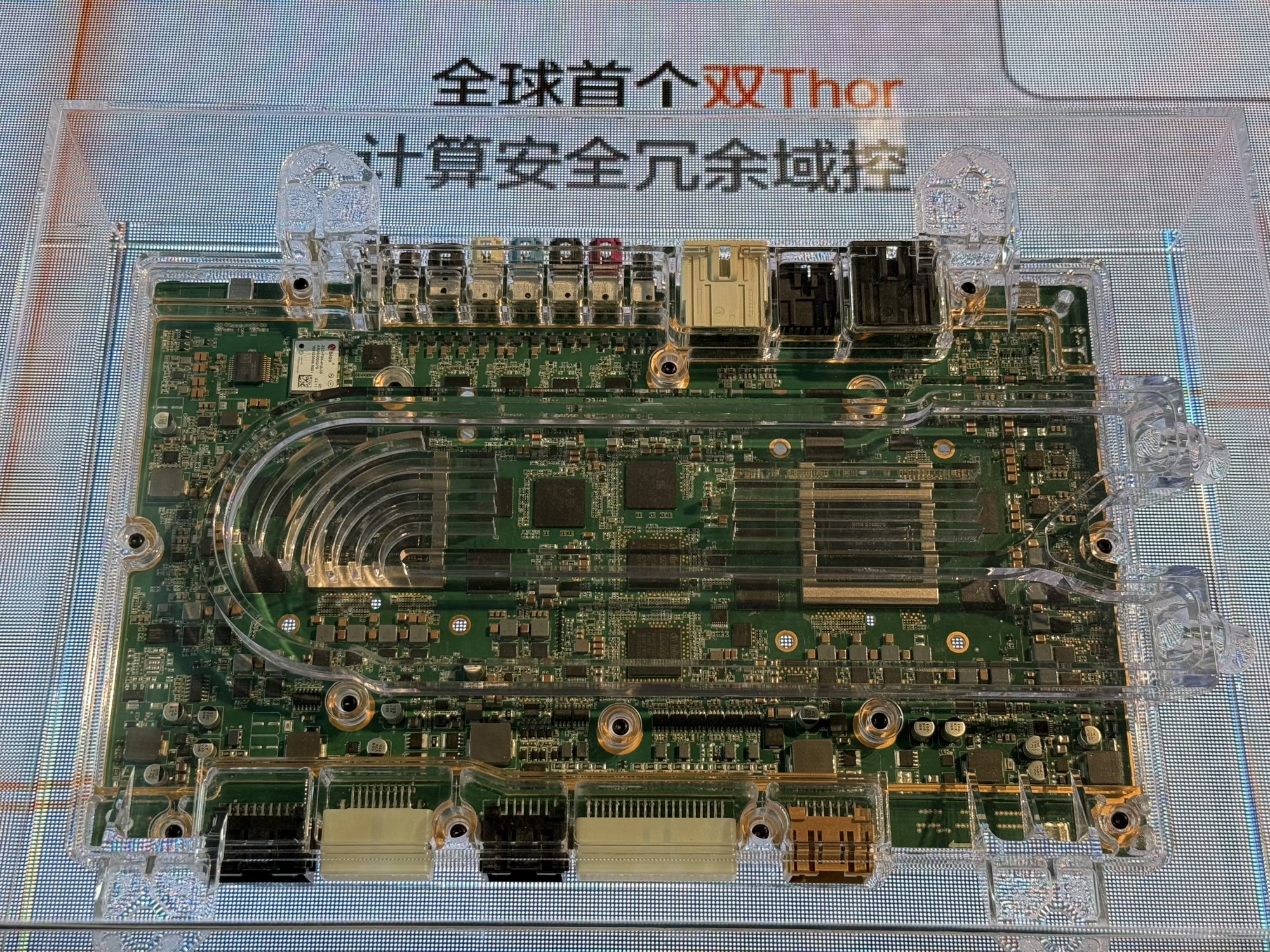
How to understand “independently researching and producing”? In this domain controller, the Thor-U chip is from NVIDIA, but the design of other parts of the controller, as well as its manufacturing, is done by ZEEKR itself. Currently, the R&D and manufacturing of domain controllers in the industry are mostly completed by Tier 1 suppliers, with relatively longer mass production cycles. Automakers’ independent R&D and in-house production can make the domain controller design more aligned with functional needs and also accelerate the mass production landing.In terms of security and stability, the Qianli Haohan H9 is equipped with dual backup for the entire safety chain, with two Thor chips ensuring mutual verification and backup.
In terms of technical architecture, there are certain differences between the Qianli Haohan H9 and H7. ZEEKR introduced the auxiliary driving Smart AI Agent algorithm architecture, deploying the “World Model” and “Cloud-Based Model” in the cloud, while the vehicle side features the new “Multimodal VLA General Scenario Model,” forming the structure of the Qianli Haohan H7.
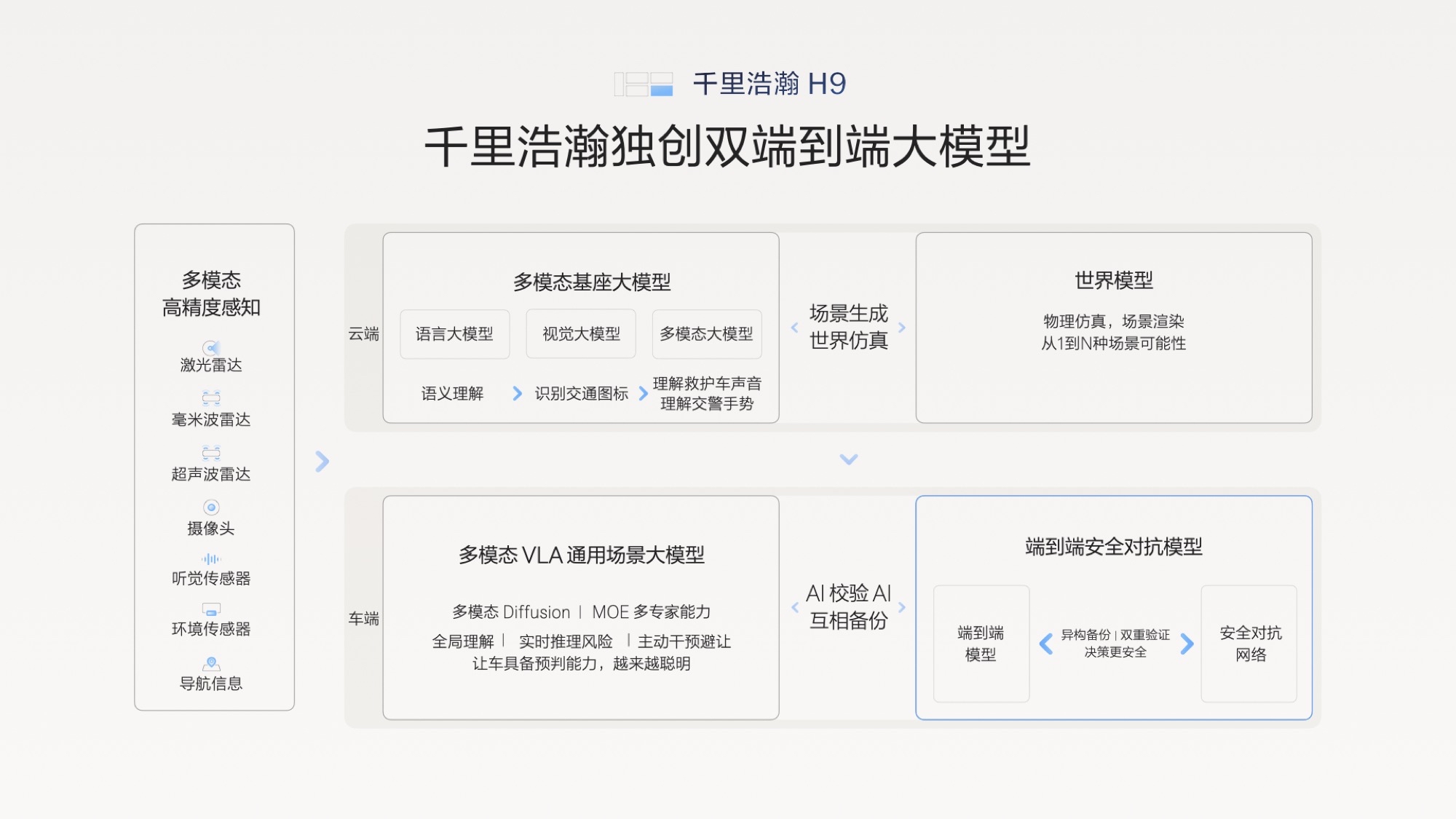
On this basis, the Qianli Haohan H9 adds the “End-to-End Adversarial Model,” utilizing AI to validate AI, with mutual backup with the “Multimodal VLA.”
Regarding L3 functionalities, ZEEKR remains conservative, not disclosing any L3 features and scenarios. At the launch, Chen Qi said: “The Qianli Haohan H9 not only supports L3 but also supports the continuous evolution and advancement of L3 to even L4 capabilities; our R&D is progressing at full speed.”
Dual-chamber, Dual-valve + Active Stabilizer Bar
What chassis technology should a luxury full-size SUV use?
ZEEKR provided four key terms: “Dinghai Intelligent Hub” motion control system, 48 V active stabilizer bar, closed dual-chamber air spring, and dual-valve CCD variable damping shock absorber.
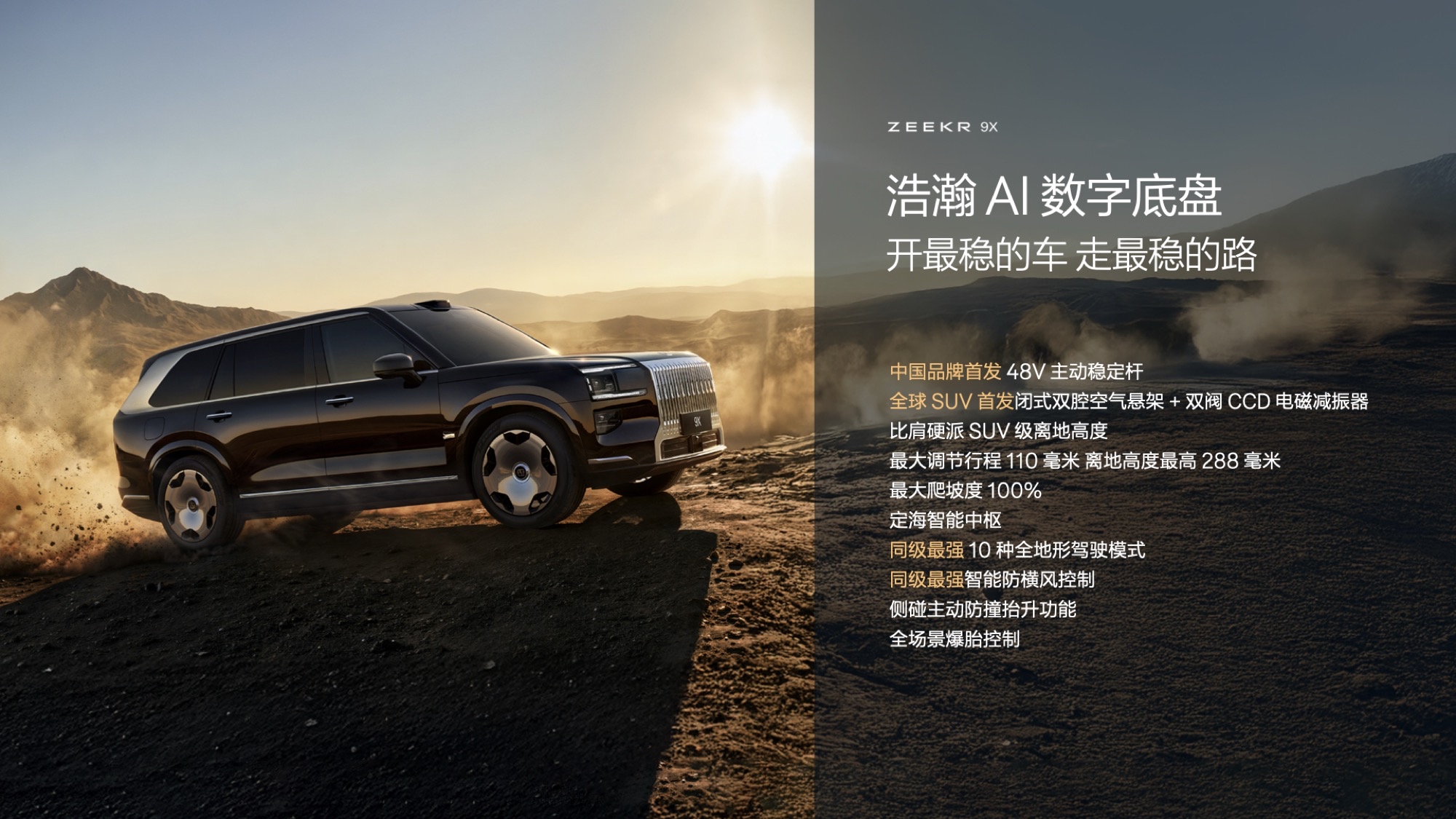
Among them, the closed dual-chamber air spring features a maximum lift stroke of 110 mm, allowing the ZEEKR 9X to achieve a maximum ground clearance of 288 mm. Coupled with the dual-valve CCD variable damping shock absorber, it enables superior handling capabilities and can climb slopes with a 100% gradient.
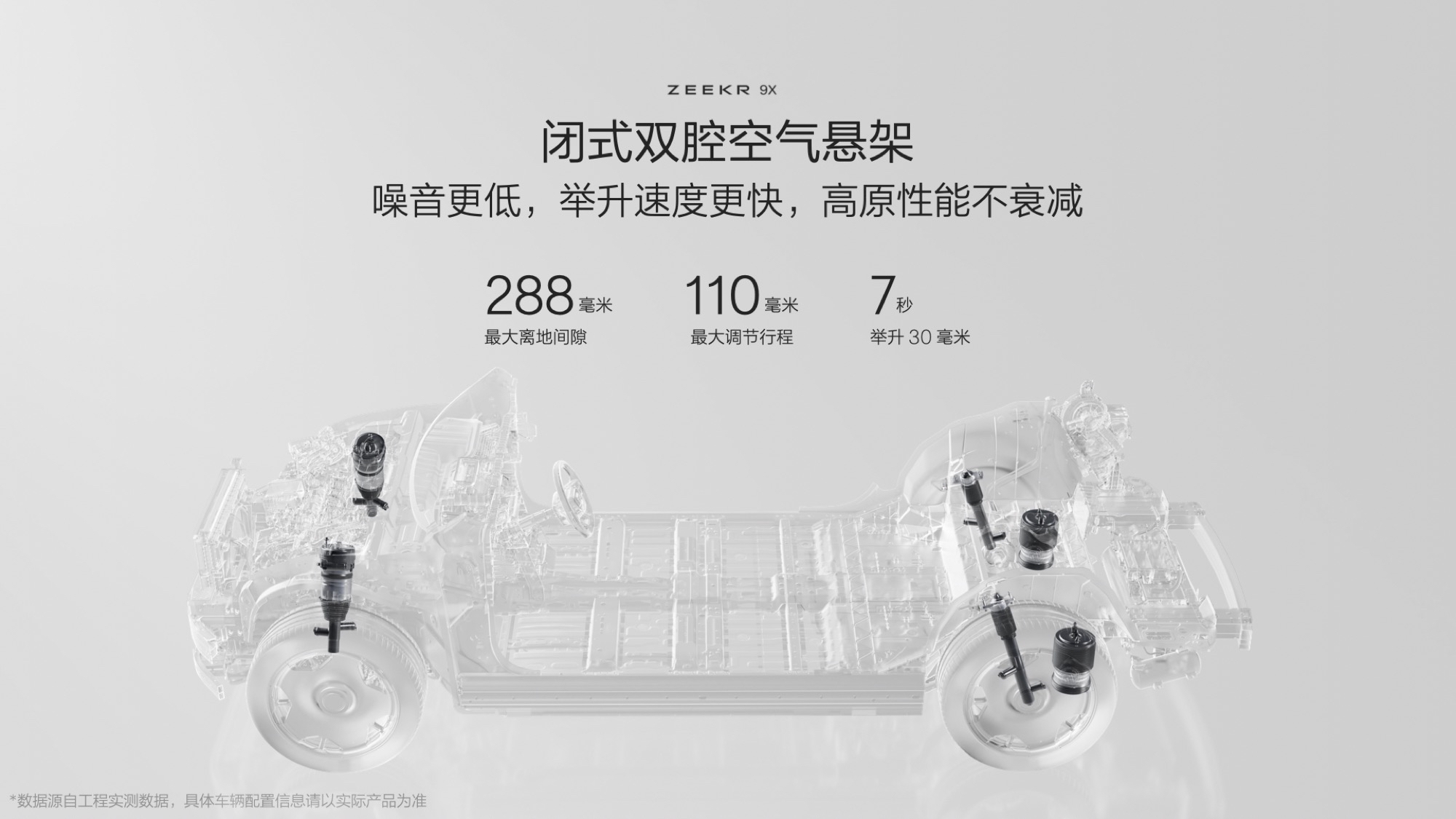
Additionally, luxury SUVs have a higher center of gravity, which may cause body roll when cornering, affecting tire grip. With the active stabilizer bar, the vehicle maintains a more stable posture on high-speed corners and rugged roads.
It’s also noteworthy that the active stabilizer bar of the ZEEKR 9X is powered by a 48 V system, enabling greater power output. According to official data, the maximum torque on one side is 1,400 N·m.
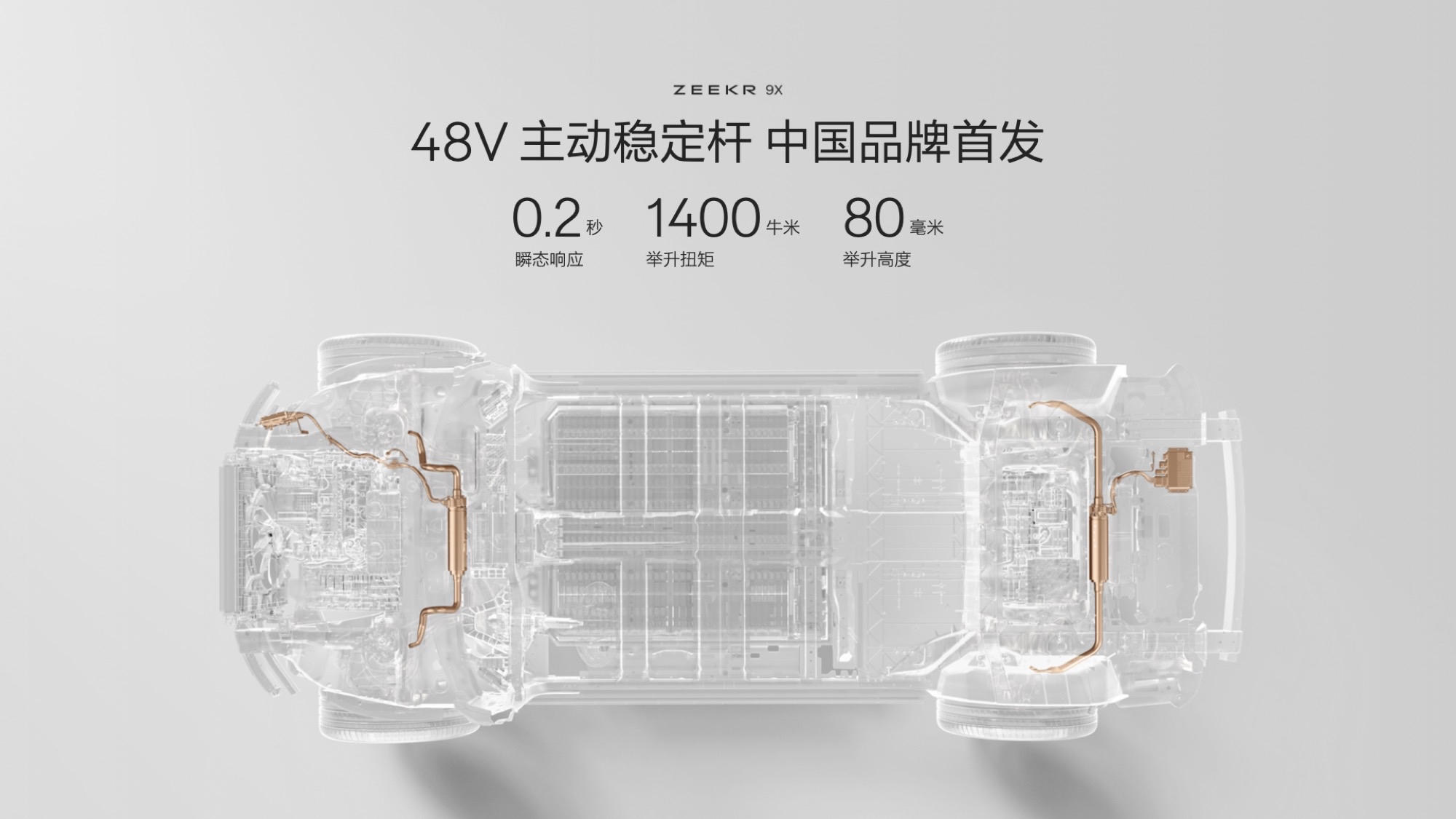
The “Dinghai Intelligent Hub” is essentially the super brain of the vehicle’s control, integrating previously independent systems like suspension, braking, steering, and propulsion through the perception of auxiliary driving, allowing real-time adjustments to vehicle posture and dynamic response under different road conditions. With this system, the ZEEKR 9X showcases two major features: the crosswind control system and the ABC active collision lift control.When crossing sea bridges or driving on mountain highways, strong crosswinds are commonly encountered. At such times, the ZEEKR 9X’s body controller can capture changes in wind direction in real-time, activating the active stabilizer bar and CCD variable damping shock absorbers to keep the vehicle stable.
ZEEKR’s real-world test video shows that under harsh conditions of level 10 crosswinds, ordinary light trucks and cars traveling at 80 km/h through the crosswind zone experienced noticeable side slipping. However, the ZEEKR 9X, traveling at the same speed, exhibited only about 0.2 m of lateral drift over 25 m and approximately 0.78 m of lateral drift over 40 m, with a tilt angle of only 1 degree.
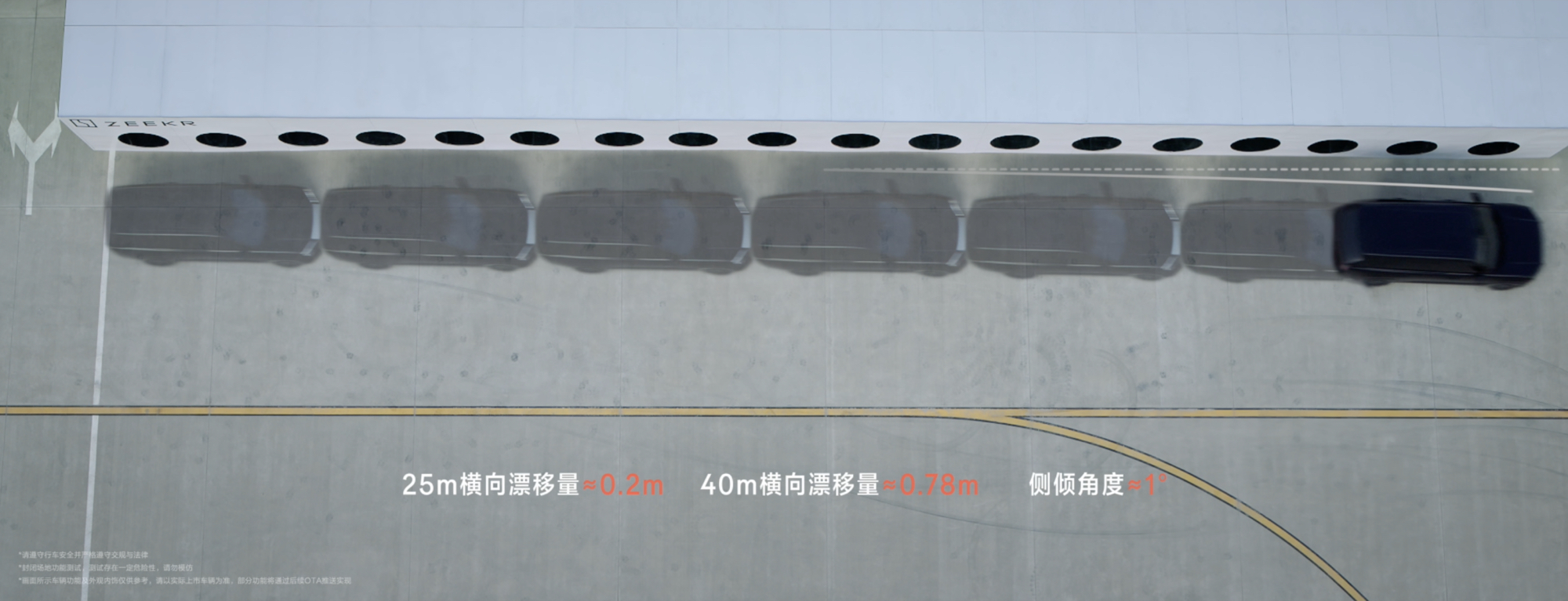
The ABC active collision lift control is designed for collision scenarios. When the vehicle’s assisted driving system senses an unavoidable side collision, this system can activate the ring-shaped active stabilizer bar within 0.5 seconds to elevate the vehicle by 80 mm, allowing the threshold beam to absorb the impact and protect the safety of the occupants. In reality, similar functions have already been incorporated into numerous luxury brands.
Safety is the Primary Criterion for Evaluating Luxury
The “Highway Tank” has always been a hallmark of ZEEKR and is now embodied in the 9X.
The ZEEKR 9X boasts a body torsional stiffness reaching 41,600 N·m/deg, surpassing both the Land Rover Range Rover and the Rolls-Royce Cullinan.
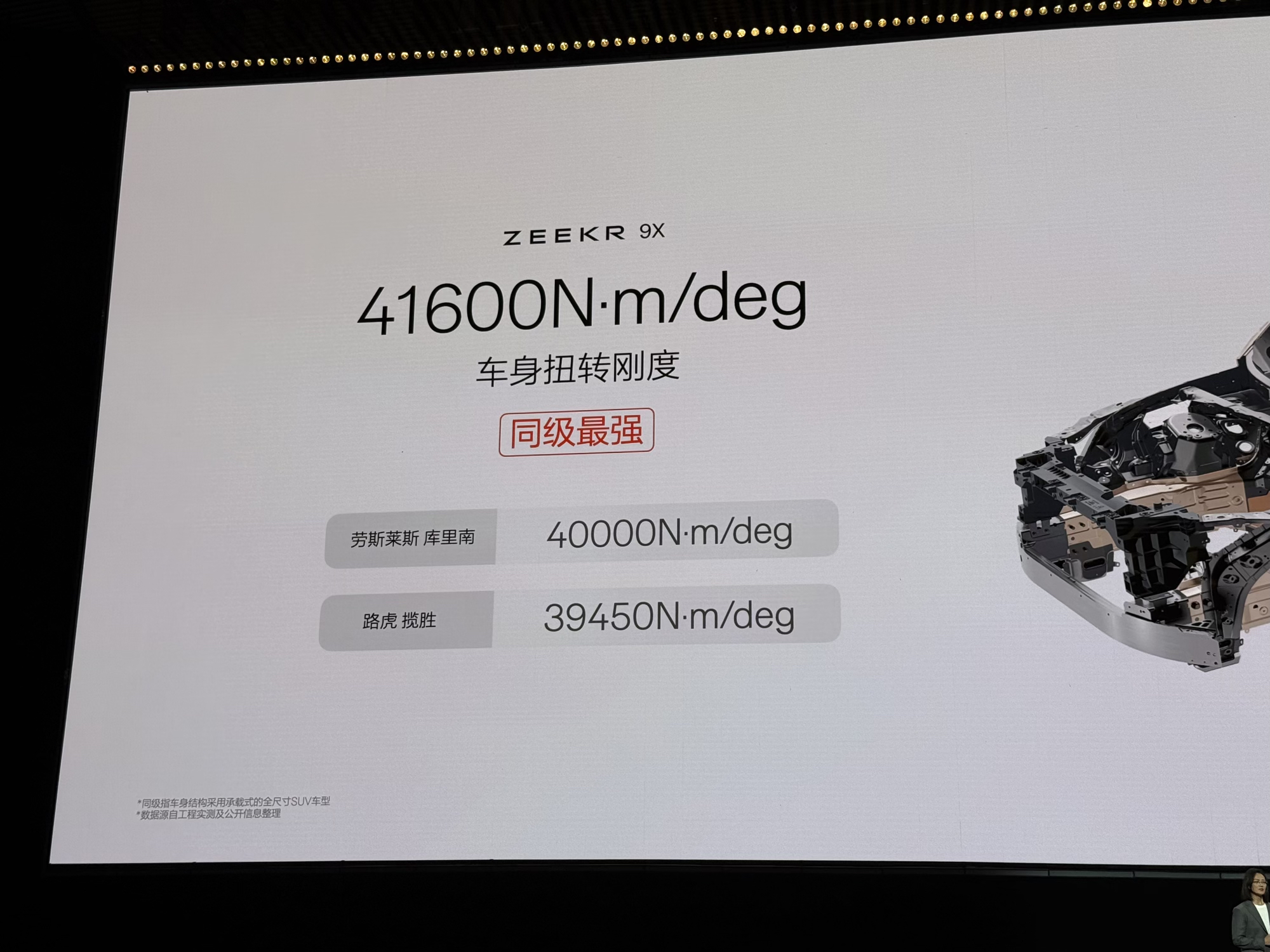
The ZEEKR 9X’s body comprises over 91% high-strength steel and aluminum alloy, with 10 locations made of high-strength steel achieving a strength of 2,000 MPa. Additionally, the continuously hot-formed reinforced sunroof ring, integrally formed main body 2000 MPa hot-formed door ring, integrated cast aluminum rear body, and integrally cast aluminum CD pillar reinforcement structure cover all passenger positions.
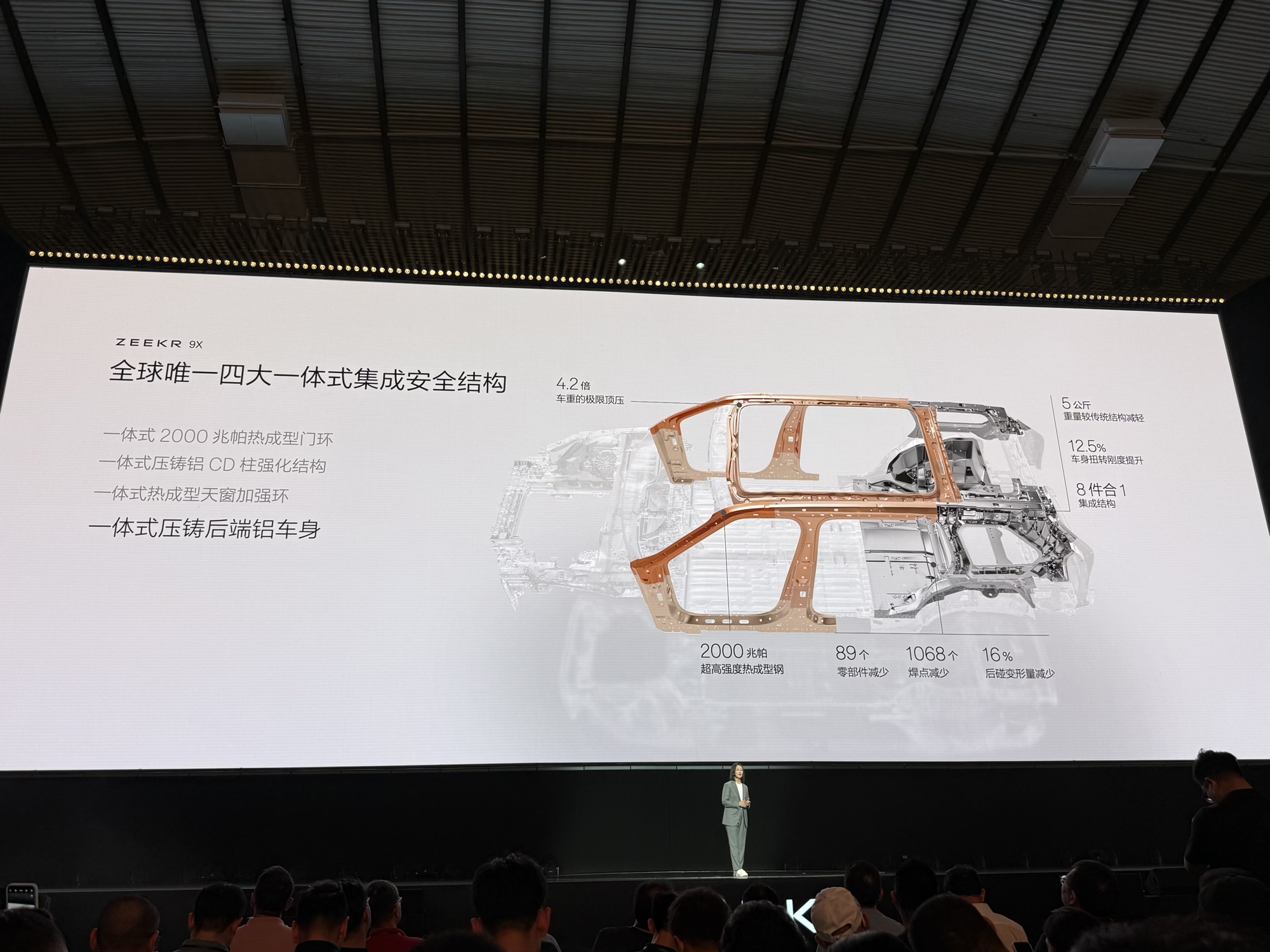
Furthermore, ZEEKR has developed a “third energy-absorbing box” in the body of the 9X, which transfers impact force from the power system to the mid-channel, absorbing collision energy, and ensuring that the engine does not intrude into the cabin upon impact.
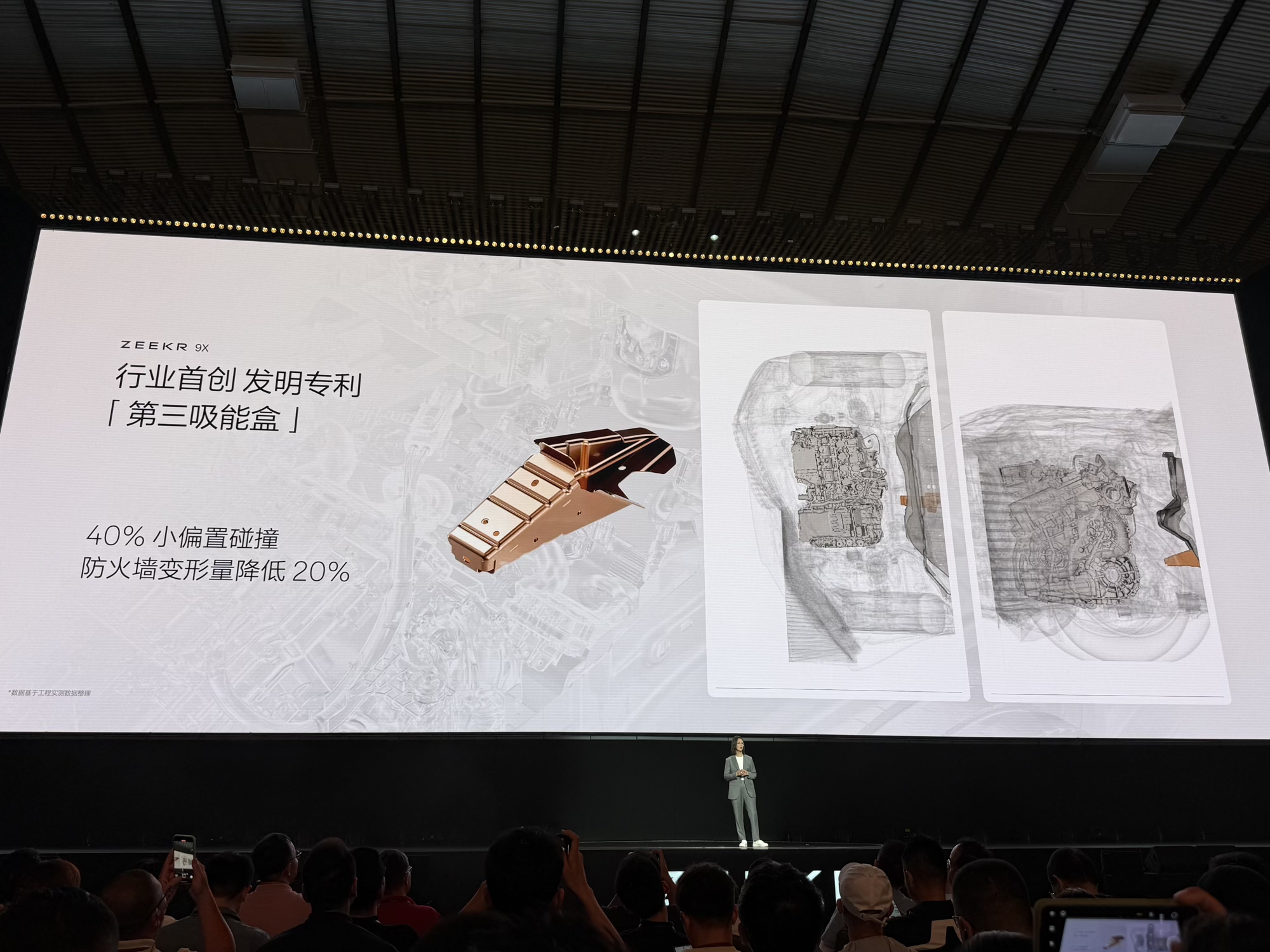
ZEEKR also added an anti-collision block to the 9X, which prevents the subframe from impacting the fuel tank during a collision, thus ensuring fuel tank safety.
In the event of a rear-end collision, the ZEEKR 9X is capable of making the power distribution box behind the third-row seats “backflip,” preventing it from impacting the third-row seats and protecting the safety of the occupants.## Conclusion
ZEEKR 9X is undoubtedly the flagship model of the ZEEKR brand and marks the beginning of a new chapter for the company.
When ZEEKR was established in 2021, the official website stated: “The birth of ZEEKR distinguishes itself from traditional car manufacturing and new players, achieving rapid evolution of intelligent pure electric technology, pioneering the third path of pure electric development with the ‘ZEEKR mode.'”
Today, ZEEKR is no longer limited to pure electric propulsion but focuses on resolving user pain points, delivering the most suitable products to customers. In another dimension, ZEEKR 9X remains committed to the principle of not making boring cars, offering high performance even in hybrid models, with the dual 8295 + dual Thor-U intelligent configuration comparable to the brains of two cars.
ZEEKR has changed, yet it remains unchanged.
This article is a translation by AI of a Chinese report from 42HOW. If you have any questions about it, please email bd@42how.com.
